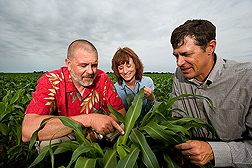Scientists Release New
Sorghum for Feed and Fuel
|
|
Though less recognizable than corn, sorghum is no stranger to the grocery store shelf, as evidenced by the flour, syrup, gluten-free bread, and other sorghum-containing products there.
On the farm, sorghum’s stalks, leaves, and multicolored grains are fed to cattle; in processing plants, they can be converted into ethanol. Now, sorghum’s future could burn brighter on both of those fronts with the release of Atlas bmr-12, a low-lignin variety.
Lignin is a cellular “glue” of sorts that imparts rigidity and strength to plant tissues. It also plays direct and indirect roles in helping plants fend off insects and pathogens. But breeding sorghum with reduced lignin can have beneficial effects, too, say plant pathologist Deanna L. Funnell, geneticist Jeffery F. Pedersen, and agronomist John J. Toy at ARS’s Grain, Forage, and Bioenergy Research Unit in Lincoln, Nebraska.
Atlas bmr-12, which was developed by the ARS team and evaluated with University of Nebraska-Lincoln colleagues Richard Grant and Amanda Oliver, is a good example of reduced-lignin’s benefits. In the laboratory, Atlas bmr-12 scored higher on fiber digestibility than standard sorghum, which should result in higher milk production and higher beef gains when cattle are fed the new variety. Atlas bmr-12’s greater fiber digestibility also raises the prospect of improved sorghum-to-ethanol conversion at the processing plants.
The researchers initially anticipated that breeding low-lignin sorghum would diminish the plants’ defensive capabilities. But they observed otherwise in tests with harmful species of Alternaria and Fusarium fungi.
In the lab, Funnell inoculated low-lignin lines—containing either bmr-6 or bmr-12 genes—and control varieties with F. moniliforme and compared the length of the red-pigmented lesions that demarcate the fungus’s spread. Inside the stems, or peduncles, of the low-lignin lines, the lesions were shorter than those of the controls, suggesting bmr-6 and bmr-12’s greater resistance. On bmr-12, for example, the lesions averaged 78 millimeters long, versus 117 millimeters for the control.
“This surprised us because lignin has been linked to disease resistance,” says Funnell. During breeding stages, Pedersen incorporated two of several genes for a trait called “brown midrib,” which is associated with reduced lignin. The researchers theorize that the genes may have disrupted the functioning of key enzymes so as to allow buildup of phenolic compounds with antifungal activity.
“We hypothesize that there’s a difference in the levels of phenolics—the precursors to lignin—and some of these have been shown to be toxic to fungi,” says Funnell. The phenolics pose no such danger to livestock or humans and may confer health benefits.
ARS has received U.S. Plant Variety Protection on Atlas bmr-12. Written seed requests should be directed to ARS’s Lincoln unit.—By Jan Suszkiw, Agricultural Research Service Information Staff.
This research is part of Plant Genetic Resources, Genomics, and Genetic Improvement, an ARS national program (#301) described on the World Wide Web at www.nps.ars.usda.gov.
Deanna L. Funnell is in the USDA-ARS Grain, Forage, and Bioenergy Research Unit, 314 Biochem, P.O. Box 830937, Lincoln, NE 68583-0937; phone (402) 472-9099, fax (402) 472-4020.
"Scientists Release New Sorghum for Feed and Fuel" was published in the September 2007 issue of Agricultural Research magazine.







